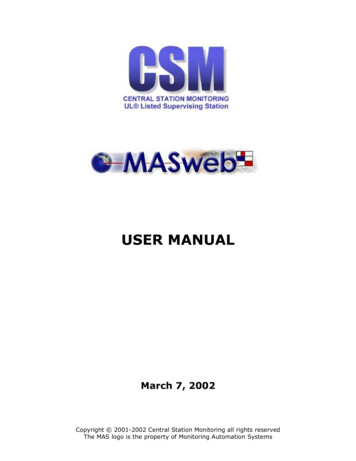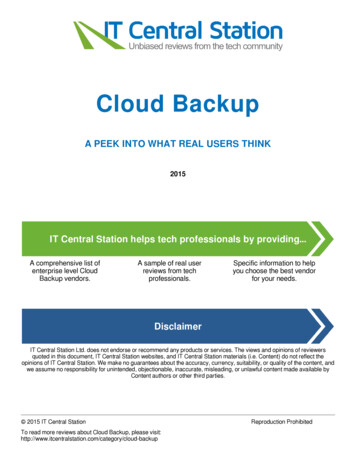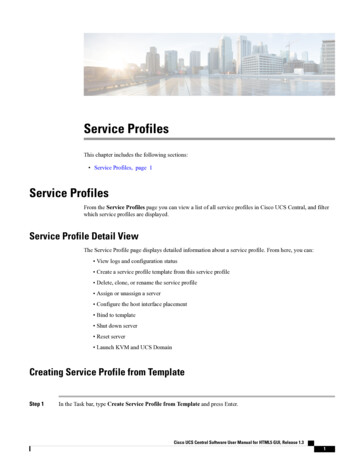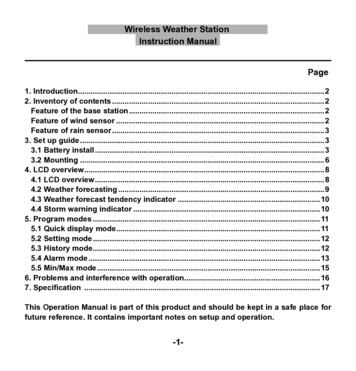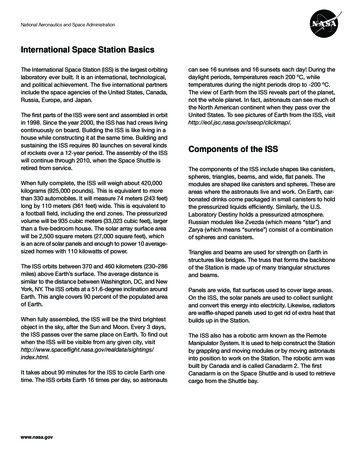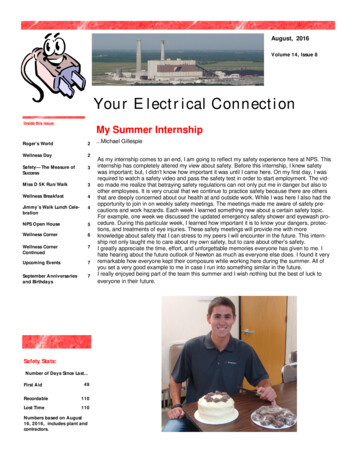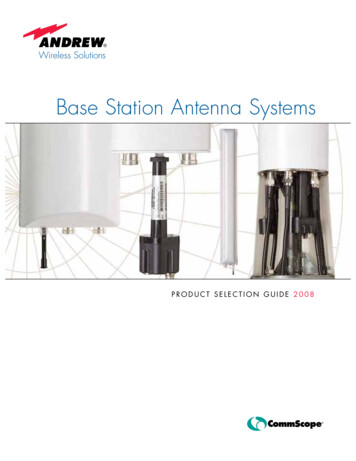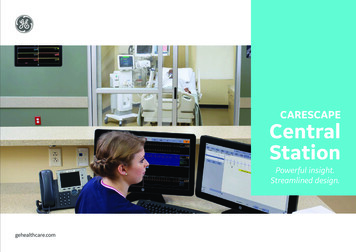
Transcription
CARESCAPECentralStationPowerful insight.Streamlined design.gehealthcare.com
One source for data.Fast. Reliable. Compact.The CARESCAPE Central Station version 2.1 brings youmore ways to view patient information. Connectivityto more data sources. Deeper insights to patients’conditions. Highly efficient workflows. All in a neat,space-saving package.You get the same clinical capabilities you’ve come to expect, withan expanded selection of hardware and display options to suityour needs.The CARESCAPE Central Station transforms a central monitoringsystem into a clinician-centric workstation. It integrates monitoringand historical data from multiple sources and presents it tocaregivers, helping them make sound decisions, reduce errors,and deliver clinical excellence. Basic capabilities include:Viewing. Observe waveforms and vital information for patientsconnected to the CARESCAPE Network.Monitoring. Admit and discharge patients and managepatient alarms.Patient condition review. View live waveforms, historicalevents, trends, full disclosure data, 12SL reports, high resolutionCRG trends, and more.Strip reports. Flag ECGs, non-ECG, and caliper strips electronically,print for the patient’s chart and send to the EMR or a remote SFTPserver for archiving for a more complete patient record.
Flexible configurations.Efficient use of space.The CARESCAPE Central Station hardware is designed toconserve space, save you precious time, and adapt to yourclinicians’ preferences.A wide screen with 16:9 aspect ratio lets you display morewaveform information, and touchscreen capability makesworkflow highly efficient.Exceptional alarm configurability helps you limit nuisancealarms, fight alarm fatigue, and create quiet spaces wherepatients can heal.
Configuration options.You can easily adapt the system hardware to fit your clinicians’ viewing needs. Options include compact configurations withno CPU cabinet – the CPU is built right into the primary display. Speakers are also built in, so more desktop space stays clearand clutter free.Standard desktop systemAll-in-one systemDisplay options for all-in-one and standard desktop systems.1Secondary displayRemote displayMirror displayA secondary display extends the work surface of the primary central station andis dedicated to the review of a single patient’s data. One keyboard and mouse canbe shared across the primary central station and the secondary display.A remote display is an exact representation of what is shown onthe primary central station. This non-interactive and non-audibledisplay is ideal for applications such as a hallway display.A mirror display provides an interactive workstation, displayingthe same patients as the primary central station. Changes madeat the primary central station are reflected at the mirror displayand changes made at the mirror are reflected at the primary.1. Customers can purchase their own remote display, up to 27''. Please see data specification sheet for more information.
Get the whole picture.Make quick, sound decisions.Consider the power of one reliable source for patient information – current and past.That’s the CARESCAPE Central Station. In critical care, cardiac care, telemetry, andemergency care, it delivers data to support confident decision-making.Review monitor data. Get active as well as historic data as patients move within orbetween care areas. You can access data on patient stays for up to six days post-discharge.Data from recent visits can give valuable insight to patients’ current conditions.High-resolution CRG (cardiorespirogram). View the most minute respiratory eventsfor neonatal patients.Full disclosure. View up to six days of data, including: Arrhythmia events Non-arrhythmia events User created events Configurable page displays of ECG, respiration, SpO2, IBP, and CO2 waveforms 12SL or 12RL derived 12-lead ECG records from monitoring sessionsST Review. Continuously monitor for subtle ST-segment changes and help detect theonset of adverse events. Data is recorded for up to six days and is available post-discharge.Data integration. Import data from the MARS ambulatory ECG review station andthe MUSE cardiology information system. Citrix support enables access to additionalclinical information.Generate event strip reports. Create custom strip reports from an ECG or non-ECGevent and send to three destinations simultaneously: EMR, laser, and/or PDF.
Powerful insight. At your fingertips.The multi-viewer window provides reassurance that point-of-care patient data is easily accessible for review and analyses.1. Alarm display unit (ADU) – Red, yellow, and cyanboxes provide quick access to up to four of the highestpriority alarms for in-depth analyses.2. System status ADU – Provides system statusinformation.3. Review alarm settings – A periodic visual notificationto review the alarm settings of patients viewed on thecentral station.4. ST review status icon – Conveys ST review status.5. Heart rate limit – Provides visualization of high andlow heart rate limits for each patient.6. Audio pause indicator – Silence a single patient whilereviewing that patient‘s data.7. Alarm volume indicator – View and adjust volumelevel based on established workflow.8. Low priority alarm audio – Signifies that low priorityaudio alarms at the central station are disabled.9. Patient selection – Backlit for better visibility.10. Care note icon – Indicates care notes were entered.Hovering over icons with a mouse will show additionalpatient information (e.g., allergy alert, nurseassignment, shift communication).11. Patient multi-viewer title bar – Red, yellow, andcyan bars are easy to see from a distance and flashbased on alarm priority. Patient names can beremoved from the display for patient privacy. Flashingtitle bar can be configured to stop flashing when analarm is silenced.12. NO COMM – Audio breakthrough when all alarmsaudio off.13. Pace is enabled.14. Software and service information – Displays thecurrent software version along with the clinicalapplication version and service platform.7 8611211135 43291410
Event review enables easy identification and selection of events to be part of the patient’s medical record.1. Filter – Filters patient events by ECG and non-ECG events.2. Add to report – Allows users to flag an event to a strip report for printingor archiving.3. Annotate – Enter free-form notes to elaborate on an event.5. Additional event indicator(s) – Conveys if a flagged event has been added to a stripreport, contains an annotation, and/or shows the non-arrhythmia alarm setting.6. Caliper measurements – Depicts location of caliper measurements taken for theevent and labels values on the strip.4. Review status – A indicates a new event, a indicates the event wasreviewed and an indicates the event was deleted.415236
The ST review feature obtains 12SL records from supported bedside monitors every minute for up to the licensed fulldisclosure length (i.e., 24, 48, 72, 96, or 144 hours). ST-segment records are also available for review post-discharge.1. Median view – Simultaneously displays reference and current 12-lead to showsubtle changes over time.22. ST Review enabled – Optional multi-viewer indicator to show that ST reviewis enabled and that additional 12-lead patient history is available.1
High-resolution graphic trends provide a significant increase in fidelity for clinical review of oxy-CRG parameters.1. Graphic trends – Offers customizable graphic trends based on workflow.3. Trend group – View graphic trends by configurable parameter group.2. Time range – Select the time range to view graphic trends. Time range optionsinclude 12, 15, and 30 minutes and 1, 2, 4, 8, 12, and 24 hours for up to 72 hours.122. 1-minute time range is available only with the CRG trend group parameters, which includes ECG-HR, RR, SPO2, SPO2-rate, UAC-mean, Art-mean, exp-CO2, and events.3
Non-arrhythmia events offer configurable options to capture parameters for respiration rate, apnea, SpO2 , and SpO2 pulserate. Automatic capture and listing in Event Review provides easy clinical access and review.1. Event review – View non-arrhythmia events.3. Event viewer – Displays the non-arrhythmia event waveforms.2. Event indicators – Shows the non-arrhythmia alarm setting.123
Data continuity provides access to historical data to help clinicians distinguish between new and pre-existing conditions. Licensingoptions allow up to six days (144 hours) of full disclosure, which can help provide valuable information relevant to a patient’scurrent condition. Post-discharge data is also useful for retrospective analyses, such as morbidity and mortality reporting.1. Full disclosure – Helps clinicians distinguish between new and pre-existingconditions and allows access to patient data for up to six days (144 hours).2. Session(s) available – Allows choice of current monitoring session(s) (grey)or prior monitoring session(s) (orange).3213. Post-discharge – View previous monitoring sessions for up to six days(144 hours). User created events can be generated from previous session data.
Strip reporting allows users to create ECG strips electronically, eliminating manual paper strip cutting and gluing.Reports can be printed for scanning into a patient’s chart or sent electronically as PDFs to the EMR or a remote SFTPserver for archiving.1. Printer destination – Save the report as a PDF, choose a network laserprinter(s), or electronically send the report directly to the patient’s recordin the hospital’s EMR system.3. Strip report – Summarize the number of events, date and time range, reportcomment, signature lines and form number.2. Strip report comment – Summarize multiple event annotations – thisis typically more than one event. Report comments can be configured aspart of the strip report.312
Enjoy high uptime. Enable peace of mind.The CARESCAPE Central Station is designed for reliable, flawless performance on a provenplatform. The latest design has fewer cables and no moving parts. The disk drive is solid-state,without cooling fans.Best of all, with InSite ExC service, delivered by secure broadband connectivity, GE experts can helpyou diagnose and resolve many issues without waiting for an engineer’s visit.3In addition, biomedical engineers can access Webmin service administration tools from a workstationto support networked device troubleshooting. They can also download clinical and servicepackage updates.3. Not available in all areas. Check with your sales representative for availability.
Imagination at workProduct may not be available in all countries and regions. Full product technical specification is availableupon request. Contact a GE Healthcare Representative for more information. Please ta subject to change. 2019 General Electric Company.GE, the GE Monogram, imagination at work, CARESCAPE, InSite, MARS, MUSE and 12LR are trademarks ofGeneral Electric Company.Citrix is a trademark of Citrix Systems, Inc. and/or one or more of its subsidiaries, and may be registered in theUnited States Patent and Trademark Office and in other countries.Reproduction in any form is forbidden without prior written permission from GE. Nothing in this material shouldbe used to diagnose or treat any disease or condition. Readers must consult a healthcare professional.JB64765US 4/19
provides access to historical data to help clinicians distinguish between new and pre-existing conditions. Licensing options allow up to six days (144 hours) of full disclosure, which can help provide valuab
